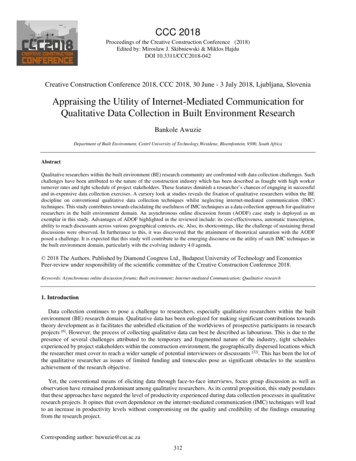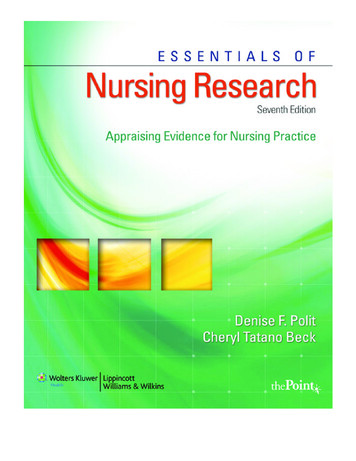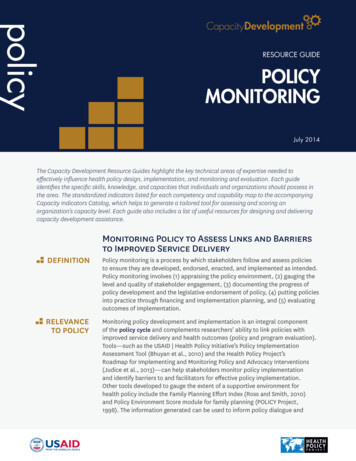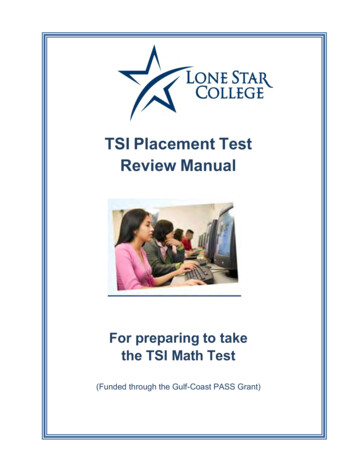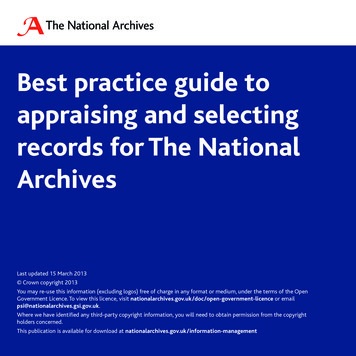
Transcription
Best practice guide toappraising and selectingrecords for The NationalArchivesLast updated 15 March 2013 Crown copyright 2013You may re-use this information (excluding logos) free of charge in any format or medium, under the terms of the OpenGovernment Licence. To view this licence, visit e or emailpsi@nationalarchives.gsi.gov.uk.Where we have identified any third-party copyright information, you will need to obtain permission from the copyrightholders concerned.This publication is available for download at nationalarchives.gov.uk/information-management
IntroductionOur joint responsibility is to work together to select records of archival value forpermanent preservation, and ensure their transfer and ongoing accessibility.This document provides information on how to appraise and select records for preservation at The NationalArchives. It applies to public record bodies who transfer records of historical value to The National Archivesand third-party contractors acting on their behalf. It is intended as a quick reference guide for those who areinvolved in the process of appraising public records.More detailed guidance is available on our website at -services/selection-and-transfer. This interactive document can be printed but will be more usefulelectronically – words and phrases in pink provide links to detailed guidance and further information thatmay be of use.Responsibilities for appraisal and selectionUnder the Public Records Act 1958: Public records bodies are responsible for the selection of records of archival value and for the safekeepingof these records The National Archives is responsible for coordinating and supervising this process by providing guidanceand supportWhat this means in practice is that: Departments (specifically the departmental records officer or equivalent and their team) plan, manage,carry out appraisal and selection of their records and document the process in line with The NationalArchives’ Records Collection Policy and supporting guidance The National Archives (specifically through the information management consultants) monitors thisprocess, provides advice, guidance and training to support departments and signs off selected records2Bookmark nationalarchives.gov.uk/information-managementfor the latest updated advice and guidance on managing your records
BackgroundFor over 50 years public records bodies have followed the system of appraisal established by the Grigg Reportin 1954. This involves appraisal of records at five years (for ongoing business value and potential archivalvalue) and 25 years (for archival value), followed by the transfer of selected records at 30 years. Using thissystem records of archival value are identified using file-by-file review. Fifty years on this system is, in mostcircumstances, no longer viable for a number of reasons: Digital information is vulnerable, and may become inaccessible due to format obsolescence ordeletion. Departments need to capture decisions about the value of information early in theinformation lifecycle. This is vital to ensure essential context is maintained and to allow for efficientand effective appraisal of the informationThe increasing volume, proliferation and complexity of digital information means that a file-by-fileapproach is prohibitive and resource-intensivePaper file-by-file review is time consuming, and may not be an efficient use of departmentalresourcesFrom 2013 the 30 year rule will be gradually reduced to 20 years over a 10-year transitiontimetable. More records will need to be reviewed in a short space of time to comply with thechange in legislationMachinery of government changes (where functions are abolished or transferred) mean that largeamounts of information often have to be appraised at short noticeDepartments should appraise their records and make selections at the highest level possible, for example, ata business function or series level. Appraisal at a file level (file-by-file review) or individual document levelshould be reserved for only those cases where appropriate. In addition digital records should be appraised asclose to creation as possible.3Bookmark nationalarchives.gov.uk/information-managementfor the latest updated advice and guidance on managing your records
This will help to: Make the process of appraisal and selection more efficient and less labour-intensiveEnsure that the business value of records is understood and embedded within departmental businessprocesses, such as in retention and disposal schedules, or ‘What to Keep’ policiesEnable departments to comply with legislation surrounding the transition to a 20 year ruleMake it easier to apply appraisal and selection to large volumes of records, including those which are‘born digital’Records collection policy and selection criteriaThe records collection policy sets out which records The National Archives will and will not collect frompublic records bodies, when we will collect them and where they will be held. Record selection continues to bebased on two broad criteria – the documentation of what government did, why and how, and the value of therecords for future historical research.The National Archives seeks to collect and preserve public records which documentthe following: The principal policies and actions of the UK central government and English and Welsh GovernmentsThe structures and decision-making processes in governmentThe state’s interaction with the lives of its citizensThe state’s interaction with the physical environment4Bookmark nationalarchives.gov.uk/information-managementfor the latest updated advice and guidance on managing your records
To implement the Records Collection Policy, The National Archives has produced a set of generic recordsselection criteria (see Annex A). These criteria provide more detailed guidance on the types of records thatshould be permanently preserved, and should be used by departments to develop their justifications forselection.In addition to this the operational selection policies provide more detailed guidance on what to select foreither specific government functions (for example, central government expenditure and diplomatic relations)or generic types of records found across government (for example, publications and grey literature, internaladministration policy records, committee records). These can be found on The National Archives' website.When carrying out methods of appraisal and selection below, departments should ensure that they use therecords collection policy, generic records selection criteria and any relevant operational selection policiesto guide selection decisions. This will ensure an efficient, consistent, auditable and transparent approach tounderstanding why records are selected for transfer to The National Archives.Top tips Departments should use the guidance above along with results of other appraisal work to produceselection criteria specific to their own needs. This is particularly important if the generic criteria eitherdo not apply, are not sufficiently detailed, or if no operational selection policies applyDepartments who wish to develop specific selection criteria for their organisations should discuss thiswith their information management consultantDocumentationDepartments should indicate on their appraisal documentation (appraisal report, series-level appraisalquestionnaire, or single transfer form) the records selection criteria, the operational selection policy number,and any other relevant appraisal guidance that apply to the selected records.5Bookmark nationalarchives.gov.uk/information-managementfor the latest updated advice and guidance on managing your records
How to carry out appraisal and selectionAppraisal and selection processStage 1:DepartmentalappraisalAppraisal reportdetermineskey businessfunctions anddefines series ofinterestStage 2:Series appraisalStage 3:File es eachseries and recordswithinSelection andcataloguingtemplatelists individualfilesOption a) sign offseries level reviewand move tostage 4Option b) sign offfiles level reviewand move tostage 4Stage 4:TransferplanningComplete serieslevel time plan foreach transferringseriesBegin preparationand cataloguing6Bookmark nationalarchives.gov.uk/information-managementfor the latest updated advice and guidance on managing your records
Departmental appraisalAppraisal at a departmental level (often referred to as ‘macro appraisal’) involves understanding theorganisation as a whole (its purpose, functions, business processes and the information created) in order tomake high-level decisions on which groups of records or categories of information to select for preservation.Departments may already have this information documented through the process of retention or What toKeep scheduling.Top tips Give particular consideration to the following areas, as this is where information/records of the highestarchival value are likely to be found:- Core functions – the main role of a department (as opposed to facilitative or common functionssuch as finance or human resources)- Statutory functions – those functions which legislation requires the department to perform (forexample one of The National Archives' statutory functions is to supervise and coordinate theprocess of appraisal and selection)Larger or more complex departments may appraise functions/business areas individually rather thantackling the whole organisation at onceTalk to business areas as they will have knowledge of the functions they carry out and the information/records they createThis guidance document focuses on the process of appraisal and selection of records of archival value forpermanent preservation.However departments should note that it is their responsibility to manage their information appropriately.As part of this, departments should know what information they create and hold, understand the value oftheir information from a business and legal perspective, know what to keep and how long for. Undertaking anappraisal approach at the departmental level will help you understand these issues and also support you infinding the answers.Further information on this and on information management generally can be found on The NationalArchives website.7Bookmark nationalarchives.gov.uk/information-managementfor the latest updated advice and guidance on managing your records
Documentation The National Archives has produced a template appraisal report to enable departments to gathertogether the information described above and document high level decisions on what records should beselected for permanent preservationAppraisal reports are considered and signed off by The National Archives records decision panel. Thishelps to ensure a consistent approach to appraisal and selection across governmentOnce selection has been agreed, relevant information is entered by the department onto the cataloguingtemplate in order to begin the transfer processSeries appraisalThe outputs of a departmental appraisal should include an understanding of series that may contain recordsof archival value, or those that can be immediately identified as not. Departments then need to appraise theseseries in more detail so that selection decisions can be made and documented. In order to do this departmentswill need to answer a series of questions about a file series in order to decide what the most appropriatemethod of appraisal should be, for example: The function/s that the series reflectsThe type of records contained, for example, policy records, case filesWhether the business area or department was the lead for this functionHaving gathered this information, departments should first consider whether a selection decision can be madeat series level. For example, when a function and all or most of the records in the series are considered to beof high value a decision could be made to select the whole series. Alternatively, a decision could be made notto select a series when the records are felt to be of little or no value. A decision could also be made to selectpart of a series for example where some of the records are considered to be of high value but the rest are ofno value. Series that can be immediately identified as not having records of archival value can be disposed ofafter decision to dispose is documented and approved by The National Archives.If a selection cannot be made at series level, then a further appraisal needs to take place at file level. There areseveral methods that can be used at file level and these are described on page 11.8Bookmark nationalarchives.gov.uk/information-managementfor the latest updated advice and guidance on managing your records
Top tips Use previous selection statistics as a guide. For example, if 80% or more of a series has been selectedpreviously then a decision could be made to selectFile series where there are a mixture of file types (for example, policy, case files, committee papers) arelikely to require further examinationCheck that a series is still what it purports to be – often file series change over time and may becomemore or less valuable as a resultSources of information that may be of use when researching a series include establishment files,official histories, departmental website, civil service yearbooks, annual reportsDocumentation The National Archives has produced a template, the series-level appraisal questionnaire, which enablesdepartments to gather together information on a file series and to document the selection decision.Departments may already have similar forms that they use for this process or wish to adapt the SeriesLevel Appraisal Questionnaire to their own specific needs. This is acceptable if the form includes space forsign off and for the appraisal decision and justificationWhere a selection decision is being made, all the appropriate records selection criteria still need to belisted and a brief indication of the scope of each need to be appliedCompleted series-level appraisal questionnaires are signed off by The National Archives informationmanagement consultantOnce it has been agreed that all or part of a series has been selected, relevant information is entered bythe department onto the series level time plan and cataloguing template in order to begin the transferprocess9Bookmark nationalarchives.gov.uk/information-managementfor the latest updated advice and guidance on managing your records
File appraisalAs mentioned, departments should avoid file or document level appraisal wherever possible. However thereare occasions when it will be required: Where there is a mixture of file types within a seriesWhere little or nothing is known about a file seriesWhere file titling is limited (for example, ‘Miscellaneous ’ or ‘General’)Four different methods can be used:1. Mixed seriesA series that contains a mixture of policy and case files. Case files should be separated out and reviewedin line with Operational Selection Policy 48 . Policy files should be appraised as a whole using the serieslevel approach above (for example, if they cover the development of primary legislation a decision couldbe made to select them all) or using one of the appraisal methods below.2. Selection criteria and file titleAn appraisal of the files takes place using selection criteria (records collection policy, generic selectioncriteria, operational selection policies, departmental selection criteria) and comparing them against the filetitles in order to select files for preservation. This method is much less effective when file titling is poor orwhere the content of files does not match the file title.3. Sift and file reviewAn appraisal takes place initially on file title, sifting out any files that are obviously worthy of selection(for example, records of a key committee or management board) or should not be selected (for example,a publication). The remaining files are then subjected to file by file review. Again this method is only reallyeffective where file titling is accurate.4. File by file reviewEach individual file is appraised on its content using relevant selection criteria (records collection policy,generic selection criteria, operational selection policies, departmental selection criteria).Bookmark nationalarchives.gov.uk/information-managementfor the latest updated advice and guidance on managing your records10
Top tips ‘Mixed series’, ‘selection criteria and file title’ and ‘sift and file review’ should be considered beforeresorting to file by file review. This will save time and resource by ensuring that file content is onlyappraised when absolutely necessaryDocumentation The review and cataloguing template should be used to list files and the selection decisionIt is essential that relevant selection criteria and additional comments are added to the appropriatecolumns on the review and cataloguing template as this will aid the process of sign off at The NationalArchivesHow to carry out appraisal and selectionThe Information Management Consultant team can provide further advice and guidance on all of the areascovered in this document. Either contact your information management consultant directly or send yourenquiry to .The National Archives holds appraisal and selection training twice a year at Kew. It is also possible, where timeand resource allow, for The National Archives to provide a tailored course for one or more departments wherethere is sufficient demand.All staff engaged in the process of appraisal and selection should attend The National Archives' training inappraisal and selection and/or tailored appraisal training session given by The National Archives within theirown or another government department.Further arrangements for transferring records to The National Archives can be found in our transfer aidememoire. If you have any questions regarding record disposition or the transfer of public records to otherPlaces of Deposit, visit our website or contact asd@nationalarchives.gsi.gov.uk.All guidance and templates referred to in this document can be found on The National Archives' website.11Bookmark nationalarchives.gov.uk/information-managementfor the latest updated advice and guidance on managing your records
Annex A - Generic records selection criteria1The principal policies and actions of UK government1.1 Records of policy decisions that had a significant impact on UK or international events and conditionswhere department was the lead (for example, foreign policy, policing, asylum and other legal cases,deployment of troops, setting the budget, intervention on foreign exchanges)1.2 Records that show the development of primary legislation where department is the lead (for example,work on White or Green papers, Bills, Acts, notes on clauses, policy working groups or committees)1.3 Records that show the development of secondary legislation where department was the lead (forexample, work on statutory instruments)1.4 Key records that illustrate how legislation was implemented where department was the lead1.5 Records of decisions that affect the way an organisation conducts its core functions (for example,decisions that set a precedent or had an impact on wider political developments)1.6 Records of projects that were particularly innovative, or were significant from the perspective of cost,risk or impact (for example, Millennium Dome project and project to build the new British Library)2The structures and decision-making process in government2.1 High-level governance records (for example, agendas, minutes and papers of Cabinet Committees,management boards, key committees, ministerial committees) – see OSP 35 – Board and Committeerecords2.2 Records that show dissolution, creation, merger of departments, agencies (for example recentmachinery of government changes under the programme to reform public bodies in 2010/11) – seeOSP 24 – Machinery of Government Changes and the management of the Civil Service 1974 to 20002.3 Records that illustrate how a body or function was privatised/nationalised (for example, privatisation ofBritish Rail)2.4 Records (for example, evidence, transcripts, reports) of tribunals, commissions, inquiries or inquests thatwere of particular public interest or had a significant impact on policy or process2.5 Constitutional relationships (for example, government relationship with devolved administrations)2.6 Records of discussions/actions where there was involvement of secretary of state/minister (unless theyare non-public records such as party political and constituency records - see OSP 12 on the centraldirection and oversight of government policy)2.7 Records reflecting the creation/development of key departmental function/structure12Bookmark nationalarchives.gov.uk/information-managementfor the latest updated advice and guidance on managing your records
3The state's interaction with the lives of its citizens3.1 Aggregated data which provides extensive information on individuals or groups (see OSP 30 oninteraction between the state and the citizen), places or organisations (case files or datasets, forexample, Census records)3.2 Records that illustrate a significant event/person/group which lead to a change in policy, set aprecedent or caused controversy and add to what is already known - see OSP 48 on case files (forexample, a legal case that set a precedent in how a particular law was applied in practice)3.3 Websites of UK Government departments and agencies in accordance with OSP 274The state's interaction with the physical environment4.1 Records which document the impact of policies/proposals on the natural environment (for example,impact of decision to build a nuclear power station on the surrounding area)4.2 Records of significant events (natural/man-made) which lead to a change in policy, or set a precedent(for example, foot and mouth crisis)4.3 Key records that establish or re-affirm UK Crown responsibilities (property and major assets) (forexample, OS maps, Thames Barrier, Channel Tunnel, Olympic venues)5Records that should always be selected5.1 Any record created earlier than 1660 (a requirement of the Public Records Act 1958)5.2 Papers cited in, or noted as consulted in the preparation of Cabinet Office official histories13Bookmark nationalarchives.gov.uk/information-managementfor the latest updated advice and guidance on managing your records
6Records that should not selected6.16.26.3Copy papers (for example, copies of policy or discussion papers circulated between departments)Information of reference/short-term valueOperational or administrative records (for example Finance records such as invoices, receipts and HRrecords such as grievance papers)6.4 Department or branch is not the lead (for example, inquiry records where the department was not thesecretariat, policy papers where another government department was the lead)6.5 Newspaper cuttings/copies of publications6.6 Routine or stand-alone case files that do not fall within criteria 3.1 or 3.26.7 Records/information captured elsewhere or already preserved at The National Archives (for exampleHansard, published advice and guidance, annual reports, Parliamentary papers)6.8 Non public-records6.9 Records that need to be retained by law but aren't considered to be of historical value (for example,finance records, health and safety, nuclear waste disposal records)6.10 Minimal content (for example very few papers on a file) or where the content doesn't addsubstantially to what is already known6.11 Public correspondence unless it forms a part of records selected under criteria 1, 2, 3, and 46.12 Records published on a departmental website providing they are captured fully into the UKgovernment web archive14Bookmark nationalarchives.gov.uk/information-managementfor the latest updated advice and guidance on managing your records
Annex B - DefinitionsAppraisal - process of distinguishing records of continuing value from those of no further value so that thelatter may be eliminated.Selection - identification of information and records that are of archival value and should be permanentlypreserved.Archival value – records that are of historical value and should be selected for permanent preservation in linewith The National Archives selection criteria.Review - term often used to describe appraisal in UK governmentSeries – a grouping of records that relate to a particular function/area of government workRecords decision panel – a panel consisting of members of staff from across The National Archives whichconsiders matters relating to selection and disposition of records, including the selection of records forpermanent preservation.15Bookmark nationalarchives.gov.uk/information-managementfor the latest updated advice and guidance on managing your records
Best practice guide to appraising and selecting records for The National Archives Last updated 15 March 2013 . The National Archives (specifically through the information management consultants) monitors this process, provides advice, guidance and training to support departments and signs off selected records

